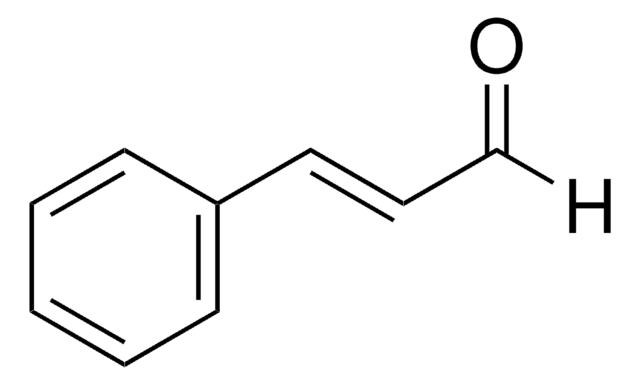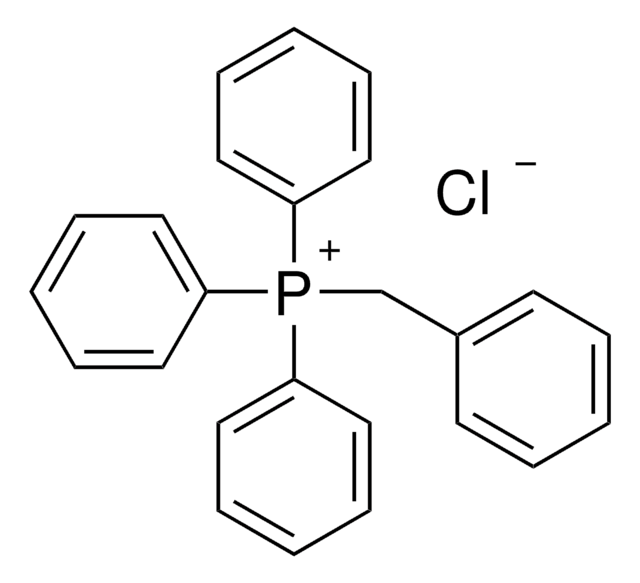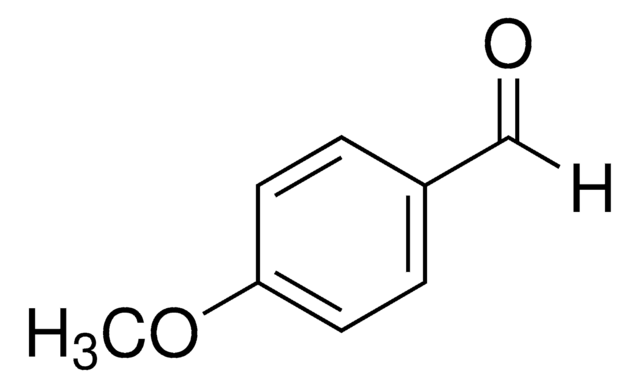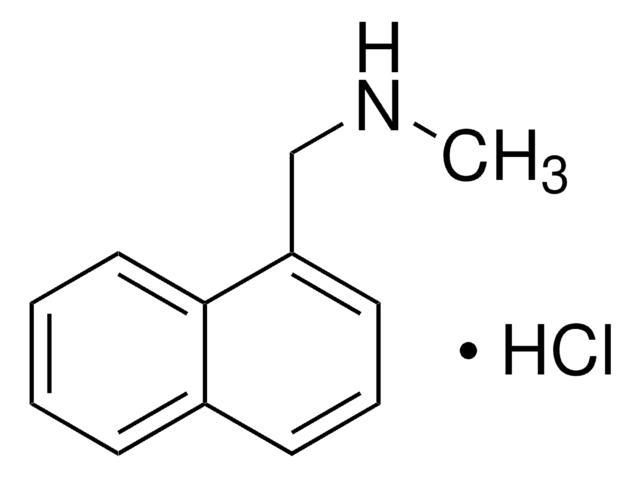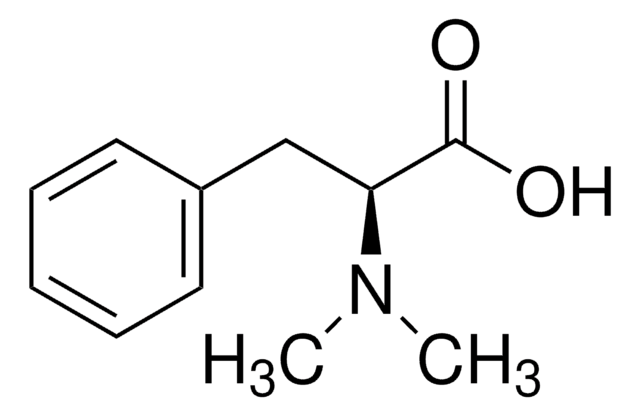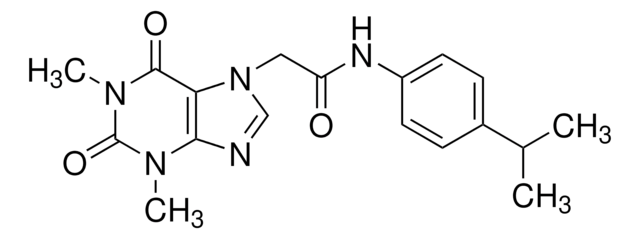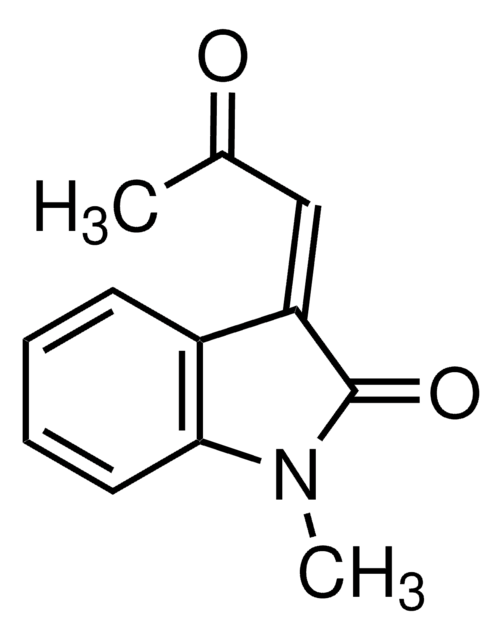Kluczowe dokumenty
W228613
Cinnamaldehyde
natural, ≥95%, FG
Synonim(y):
Cinnamal, Cinnamic aldehyde, 3-Phenylprop-2-enal
About This Item
Polecane produkty
pochodzenie biologiczne
cassia oil
klasa czystości
FG
Fragrance grade
Halal
Kosher
natural
agency
follows IFRA guidelines
zgodność regionalna
EU Regulation 1223/2009
EU Regulation 1334/2008 & 178/2002
FDA 21 CFR 117
FDA 21 CFR 182.60
Próba
≥95%
skład
contains IFRA restricted cinnamaldehyde
charakterystyka ekologicznej alternatywy
Less Hazardous Chemical Syntheses
Use of Renewable Feedstocks
Learn more about the Principles of Green Chemistry.
sustainability
Greener Alternative Product
współczynnik refrakcji
n20/D 1.621 (lit.)
bp
248 °C (lit.)
gęstość
1.05 g/mL at 25 °C (lit.)
Zastosowanie
flavors and fragrances
Dokumentacja
see Safety & Documentation for available documents
alergen pokarmowy
no known allergens
alergen zapachowy
cinnamal
kategoria ekologicznej alternatywy
Organoleptyczne
cinnamon; spicy; sweet; warm
ciąg SMILES
O=C\C=C\c1ccccc1
InChI
1S/C9H8O/c10-8-4-7-9-5-2-1-3-6-9/h1-8H/b7-4+
Klucz InChI
KJPRLNWUNMBNBZ-QPJJXVBHSA-N
Szukasz podobnych produktów? Odwiedź Przewodnik dotyczący porównywania produktów
Powiązane kategorie
Opis ogólny
Zastosowanie
- Preparation and sustained-release of chitosan-alginate bilayer microcapsules containing aromatic compounds with different functional groups.: This research discusses the development of chitosan-alginate bilayer microcapsules for the sustained release of aromatic compounds, including cinnamaldehyde, highlighting their potential applications in biochemistry and drug delivery (Wang et al., 2024).
- Evaluation of Antimicrobial and Preservative Effects of Cinnamaldehyde and Clove Oil in Catfish (Ictalurus punctatus) Fillets Stored at 4 °C.: This study evaluates the antimicrobial and preservative effects of cinnamaldehyde in combination with clove oil on catfish fillets, indicating its potential for food preservation applications (Ebirim and Long, 2024).
- Hyaluronic acid-based multifunctional bio-active coating integrated with cinnamaldehyde/hydroxypropyl-β-cyclodextrin inclusion complex for fruit preservation.: This research presents a hyaluronic acid-based bio-active coating incorporating cinnamaldehyde for fruit preservation, demonstrating its potential in extending the shelf life of perishable goods (Zhou et al., 2024).
Hasło ostrzegawcze
Warning
Zwroty wskazujące rodzaj zagrożenia
Zwroty wskazujące środki ostrożności
Klasyfikacja zagrożeń
Acute Tox. 4 Dermal - Aquatic Chronic 3 - Eye Irrit. 2 - Skin Irrit. 2 - Skin Sens. 1
Kod klasy składowania
10 - Combustible liquids
Klasa zagrożenia wodnego (WGK)
WGK 1
Temperatura zapłonu (°F)
221.0 °F - Pensky-Martens closed cup
Temperatura zapłonu (°C)
105 °C - Pensky-Martens closed cup
Środki ochrony indywidualnej
Faceshields, Gloves, Goggles, type ABEK (EN14387) respirator filter
Wybierz jedną z najnowszych wersji:
Masz już ten produkt?
Dokumenty związane z niedawno zakupionymi produktami zostały zamieszczone w Bibliotece dokumentów.
Klienci oglądali również te produkty
Global Trade Item Number
| SKU | GTIN |
|---|---|
| W228613-100G | |
| W228613-100G-K | 4061838093226 |
| W228613-1KG-K | 4061838256775 |
| W228613-1KG | |
| W228613-5KG | |
| W228613-5KG-K | 4061838179821 |
| W228613-SAMPLE | |
| W228613-SAMPLE-K | 4061838248954 |
Nasz zespół naukowców ma doświadczenie we wszystkich obszarach badań, w tym w naukach przyrodniczych, materiałoznawstwie, syntezie chemicznej, chromatografii, analityce i wielu innych dziedzinach.
Skontaktuj się z zespołem ds. pomocy technicznej